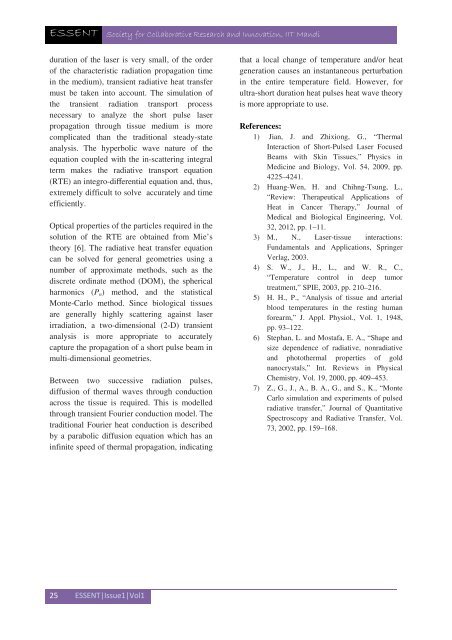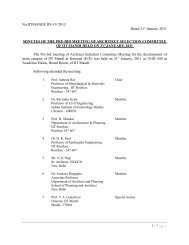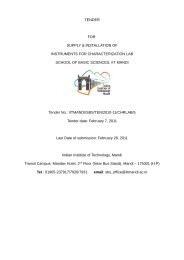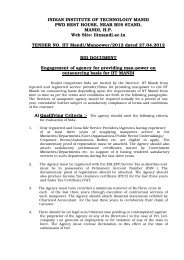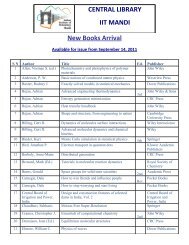Issue1. Vol.1 (April, 2013) - IIT Mandi
Issue1. Vol.1 (April, 2013) - IIT Mandi
Issue1. Vol.1 (April, 2013) - IIT Mandi
- No tags were found...
Create successful ePaper yourself
Turn your PDF publications into a flip-book with our unique Google optimized e-Paper software.
ESSENT Society for Collaborative Research and Innovation, <strong>IIT</strong> <strong>Mandi</strong>duration of the laser is very small, of the orderof the characteristic radiation propagation timein the medium), transient radiative heat transfermust be taken into account. The simulation ofthe transient radiation transport processnecessary to analyze the short pulse laserpropagation through tissue medium is morecomplicated than the traditional steady-stateanalysis. The hyperbolic wave nature of theequation coupled with the in-scattering integralterm makes the radiative transport equation(RTE) an integro-differential equation and, thus,extremely difficult to solve accurately and timeefficiently.Optical properties of the particles required in thesolution of the RTE are obtained from Mie’stheory [6]. The radiative heat transfer equationcan be solved for general geometries using anumber of approximate methods, such as thediscrete ordinate method (DOM), the sphericalharmonics (P n ) method, and the statisticalMonte-Carlo method. Since biological tissuesare generally highly scattering against laserirradiation, a two-dimensional (2-D) transientanalysis is more appropriate to accuratelycapture the propagation of a short pulse beam inmulti-dimensional geometries.Between two successive radiation pulses,diffusion of thermal waves through conductionacross the tissue is required. This is modelledthrough transient Fourier conduction model. Thetraditional Fourier heat conduction is describedby a parabolic diffusion equation which has aninfinite speed of thermal propagation, indicatingthat a local change of temperature and/or heatgeneration causes an instantaneous perturbationin the entire temperature field. However, forultra-short duration heat pulses heat wave theoryis more appropriate to use.References:1) Jian, J. and Zhixiong, G., “ThermalInteraction of Short-Pulsed Laser FocusedBeams with Skin Tissues,” Physics inMedicine and Biology, Vol. 54, 2009, pp.4225–4241.2) Huang-Wen, H. and Chihng-Tsung, L.,“Review: Therapeutical Applications ofHeat in Cancer Therapy,” Journal ofMedical and Biological Engineering, Vol.32, 2012, pp. 1–11.3) M., N., Laser-tissue interactions:Fundamentals and Applications, SpringerVerlag, 2003.4) S. W., J., H., L., and W. R., C.,“Temperature control in deep tumortreatment,” SPIE, 2003, pp. 210–216.5) H. H., P., “Analysis of tissue and arterialblood temperatures in the resting humanforearm,” J. Appl. Physiol., Vol. 1, 1948,pp. 93–122.6) Stephan, L. and Mostafa, E. A., “Shape andsize dependence of radiative, nonradiativeand photothermal properties of goldnanocrystals,” Int. Reviews in PhysicalChemistry, Vol. 19, 2000, pp. 409–453.7) Z., G., J., A., B. A., G., and S., K., “MonteCarlo simulation and experiments of pulsedradiative transfer,” Journal of QuantitativeSpectroscopy and Radiative Transfer, Vol.73, 2002, pp. 159–168.25 ESSENT|Issue1|Vol1


